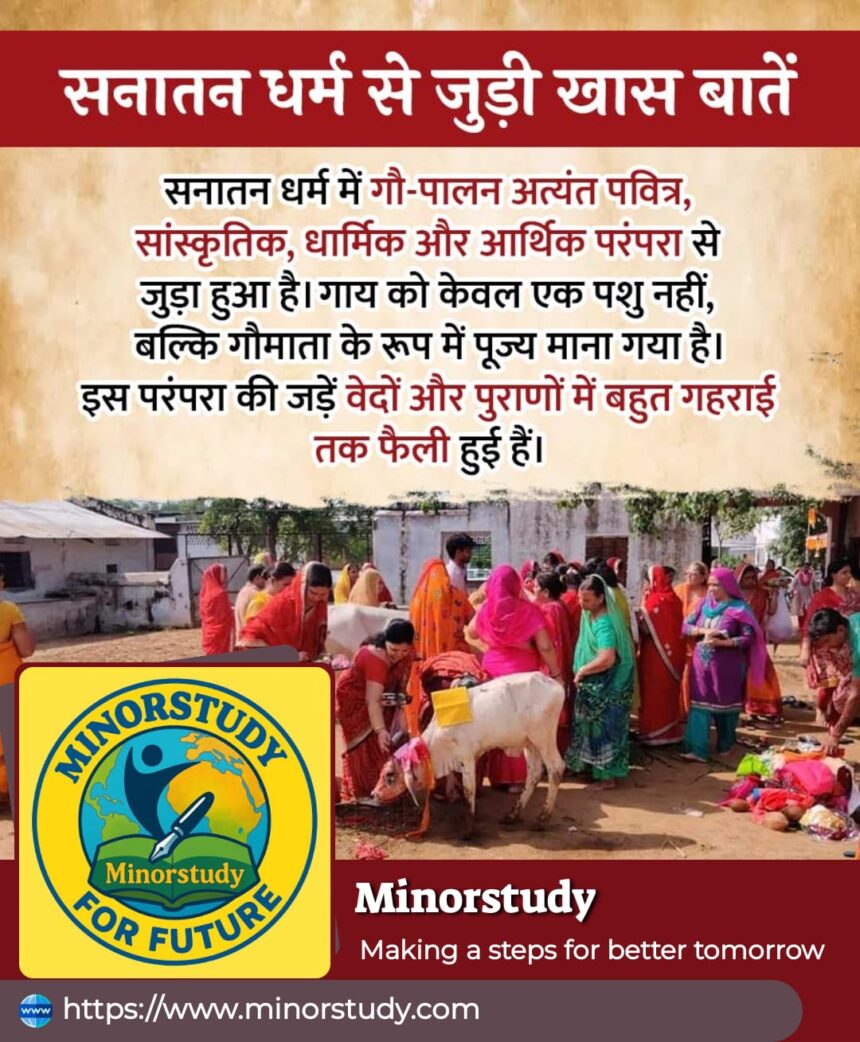9 Heartwarming Truths About Cow Worship in Sanatan Dharma – A Sacred Bond Beyond Religion
Cow Worship in Sanatan Dharma: In the eternal stream of Sanatan Dharma—the world’s oldest spiritual tradition—the cow is not merely a creature of flesh and bone. She is Gaumata: a symbol of life, compassion, dharma, and divinity. Cow rearing and reverence in Sanatan Dharma is not a cultural relic; it is a living tradition embedded deeply in the Vedas, Puranas, Upanishads, and Dharmashastras.
Across centuries, the cow has occupied a central place in Indian spirituality, economy, and social life. Even today, she continues to guide and nurture generations with her silent strength and nourishing gifts.
Let us explore the history, facts, observances, FAQS, significance, and real-life impact of this age-old practice that unites spiritual values with daily life in a beautifully human and heartfelt way.
📜 Ancient History of Cow Worship in Sanatan Dharma
The reverence for the cow is not a modern development. Its roots go back to the earliest Vedic scriptures:
-
In the Rigveda, cows are called Aghnya (not to be killed) and Kamadhenu (the wish-fulfilling mother).
-
The Atharvaveda equates the cow with wealth, health, and prosperity.
-
Lord Krishna, in his divine leelas, is always associated with cowherding (Gopal).
-
Rishi Vashistha had Nandini, a divine cow who could fulfill desires.
-
The Mahabharata and Ramayana feature cows as symbols of dharma, sacrifice, and sustenance.
From yagnas to rituals, from temples to homes—the cow remains inseparable from the sacred rhythm of Sanatan Dharma.
🗓️ Timeline: The Sacred Journey of the Cow Worship in Sanatan Dharma
| Period | Significance |
|---|---|
| c. 1500 BCE | Rigveda composed; cows declared sacred and protected. |
| 1000 BCE–500 BCE | Cow milk, ghee, and dung used in Vedic rituals. |
| 3rd century BCE | Emperor Ashoka banned cow slaughter in many parts of his empire. |
| 4th century CE | Gupta period saw widespread cow-based agrarian economy. |
| 12th–15th century | Bhakti saints like Tulsidas and Surdas glorify cows in kirtans. |
| 19th–20th century | Swami Dayanand Saraswati and Mahatma Gandhi promote cow protection. |
| Modern Era | Cow sanctuaries (Gaushalas) and cow-based organic farming revive traditional respect. |
✅ 9 Special Facts That Show the Importance of the Cow Worship in Sanatan Dharma
1. Cow Is a Symbol of Motherhood (Gaumata)
Just like a mother provides for her child, the cow selflessly gives milk, dung, urine, and labor. She is not consumed, but honored as the sustainer of life.
2. Cow’s Body Is Considered a Divine Abode
It is believed that 33 crore (330 million) deities reside in the body of the cow:
-
Brahma in the forehead
-
Vishnu in the neck
-
Shiva in the heart
-
Saraswati on the tongue
-
Lakshmi at the rear
This belief makes cow protection a spiritual duty.
3. Every Part of the Cow Has a Purpose
| Part | Benefit |
|---|---|
| Milk | Nutrition, used in abhishekams |
| Ghee | Yagna, Ayurvedic medicines |
| Urine (Gomutra) | Disinfectant, medicine |
| Dung (Gobar) | Fertilizer, fuel, antiseptic |
| Curd & Buttermilk | Probiotic food, digestion aid |
Panchagavya (a sacred blend of five cow products) is used in temple rituals and spiritual purification.
4. Krishna – The Divine Cowherd (Gopal)
Lord Krishna’s childhood in Gokul and Vrindavan celebrates the joy and spirituality of cowherding. His titles—Govind, Gopal, and Murlidhar—all connect him deeply with cows.
5. The Cow Is Central to Yagna and Dharma
In all Vedic sacrifices, ghee and dung from cows are used to maintain purity and sanctity. The smoke from such rituals is said to purify the environment.
6. Cow-Based Economy in Ancient India
The cow was once the main measure of wealth. Dowries, donations, and taxes were given in cattle. Farmers depended on cows and bulls for ploughing fields and irrigation.
7. Cow Slaughter Was Banned in Ancient and Medieval India
Not just in Hindu kingdoms, even Buddhist and Jain rulers promoted cow protection. Ashoka’s edicts mention non-violence towards cows as part of his dharma policy.
8. Gaushalas: Sanctuaries of Compassion
Even today, India has over 5,000 Gaushalas (cow shelters) where non-productive or abandoned cows are cared for. This reflects Sanatan Dharma’s commitment to seva (selfless service).
9. Cow Protection Movements in Modern India
Swami Vivekananda, Lokmanya Tilak, and Mahatma Gandhi all emphasized cow protection as part of national identity and dharma. Gandhi once said,
“The cow is a poem of pity. She is the mother to millions of Indian mankind.”
🧠 FAQs about Cow and Sanatan Dharma
Q1: Why is the cow considered sacred in Hinduism?
A: Because she is a giver of life-sustaining resources and is considered a symbol of motherhood and selfless service.
Q2: Is there a mention of cow worship in the Vedas?
A: Yes. Rigveda and Atharvaveda praise the cow as Aghnya (not to be killed) and as a provider of prosperity.
Q3: What is Panchagavya?
A: A mixture of five cow products: milk, curd, ghee, urine, and dung, used for spiritual and medicinal purposes.
Q4: Do all Hindus worship the cow?
A: While reverence varies, most followers of Sanatan Dharma consider the cow sacred and avoid harm to her.
Q5: Can cow products be used in daily life?
A: Absolutely. Cow dung is used as fuel and fertilizer, cow urine as antiseptic, and milk as nourishment.
🎉 Observance in Daily Life and Festivals
Cows are worshipped especially on:
-
Govardhan Puja (the day after Diwali)
-
Gopashtami
-
Krishna Janmashtami
-
Makar Sankranti (decorating cows in villages)
-
Gaushala Seva Diwas (in many regions)
During these observances, cows are bathed, decorated with garlands, tilak applied, and fed with jaggery, green grass, and bananas.
💫 Real-Life Impact and Importance Today
In today’s fast-paced world, cow-centric practices still offer tangible and spiritual value:
-
Organic farming through gobar and gomutra.
-
Cow-based entrepreneurship through dairy and Ayurvedic products.
-
Mental health benefits through seva and compassion.
-
Environmental conservation using bio-fuels and bio-pesticides.
-
Cultural continuity through family-level pujas and village Gaushalas.
🙏 Wishing Message
“May Gaumata bless your home with nourishment, peace, and spiritual wisdom. Let every act of kindness towards her multiply into prosperity and purity in your life.”
Jai Gaumata! Jai Sanatan Dharma!
🧭 Conclusion: Why It Matters
Cow Worship in Sanatan Dharma: In Sanatan Dharma, the cow is not merely worshipped. She is embraced as a living embodiment of dharma, seva, and sustainability. In an age where nature is exploited and traditions are forgotten, the cow reminds us of the value of gratitude, respect for life, and holistic well-being.
To revere Gaumata is to honor the very cycle of life — to give more than we take, to nurture without conditions, and to serve without expectation.
That is the timeless truth of Sanatan Dharma.
#SanatanDharma #CowWorship #Gaumata #VedicTradition #IndianCulture #HinduBeliefs #SacredCow #Gopashtami #CowProtection #SpiritualIndia








